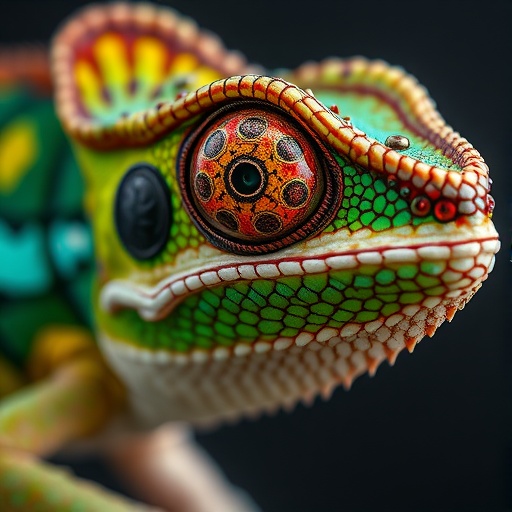In a groundbreaking study published in Scientific Reports, researchers have uncovered fascinating new insights into the evolution of chameleons, with a particular focus on their highly specialized optic nerve morphology. This research moves beyond traditional classifications of chameleons by delving into the intricate evolutionary adaptations that have given rise to their unique visual systems. The revelations surrounding the optic nerves of chameleons are not only intriguing but also shed light on the complexities of sensory adaptation in reptiles.
Chameleons are widely recognized for their striking color-changing abilities and unique physical characteristics, such as their prehensile tails and independently moving eyes. However, the research led by Collins, Bauer, and Diaz reveals that there is much more beneath the surface. By employing advanced imaging techniques, the team meticulously examined the anatomy of the optic nerves in various chameleon species, allowing them to map out the intricate neural pathways responsible for their renowned visual acuity.
One of the key findings of the study indicates that chameleons possess an exceptionally specialized optic nerve morphology that appears uniquely adapted to their habitat and lifestyle. This enhanced structure facilitates their ability to perceive and react to their surroundings with remarkable speed. The researchers discovered that the optic nerves exhibit distinctive branching patterns, which optimize visual processing and enhance the processing speed of visual information. This adaptation seems crucial for hunting, avoiding predators, and navigating their complex arboreal environments.
The study also highlights the evolutionary pressures that chameleons have faced over time. As these reptiles have adapted to various ecological niches, their visual systems have honed in on specific functionalities that support their survival. The researchers believe that the unique adaptations found in chameleon optic nerves may serve as a model for understanding how other species have evolved their sensory modalities.
In addition to the structural aspects, the research team explored the molecular underpinnings behind the specialized optic nerve morphology. They identified key genetic expressions involved in neural growth and development, suggesting a link between genetics and the evolution of sensory systems. This insight provides a deeper understanding of how evolutionary pressures shape not just physical traits but also the underlying biological mechanisms that drive adaptation.
Moreover, the ecological implications of these findings extend beyond chameleons themselves. The research offers a window into the evolutionary dynamics of reptiles and their adaptation to complex environments. As climate change and habitat destruction continue to threaten biodiversity, understanding the evolutionary responses of species like chameleons becomes increasingly vital.
The visual systems of chameleons are truly a marvel of evolution, and this study provides compelling evidence of the intricate relationship between form and function. The specialized optic nerve morphology revealed in this research serves as a testament to the evolutionary ingenuity that has allowed chameleons to thrive in their environments. With their unique adaptations, chameleons exemplify the concept of evolutionary specialization, demonstrating how particular traits can be finely tuned to meet ecological challenges.
Notably, the findings of this study also pose intriguing questions for future research. As scientists continue to investigate the broader implications of these adaptations, there is great potential to uncover additional layers of complexity in sensory evolution. The researchers encourage further investigations into other sensory systems among reptiles and other vertebrates to elucidate potential parallels and divergences in evolutionary paths.
As the research community digests these findings, the impact of this study may reverberate throughout not only herpetology but also the fields of evolutionary biology and genetics. The nuanced understanding of chameleon optic nerve morphology presented here provides an important foundation for future explorations into the intersection of morphology, function, and genetic mechanisms in evolutionary processes.
By sharing their discoveries with a wider audience, Collins, Bauer, and Diaz hope to inspire a greater appreciation for the evolutionary narratives embedded within the natural world. As more research sheds light on the fascinating adaptations of various species, it becomes increasingly clear that evolution is a journey filled with remarkable stories of survival and adaptation.
In conclusion, the work presented by Collins and his colleagues opens a new chapter in our understanding of chameleons and their extraordinary evolution. This study not only highlights the complexity of their optic nerve morphology but also exemplifies the intricate ways in which living organisms adapt to their environments. With these insights, we are left with a renewed sense of wonder about the natural world and the evolutionary processes that shape it.
Subject of Research: Chameleon optic nerve morphology and its evolutionary implications
Article Title: A new twist in the evolution of chameleons uncovers an extremely specialized optic nerve morphology.
Article References:
Collins, E., Bauer, A.M., Diaz, R.E. et al. A new twist in the evolution of chameleons uncovers an extremely specialized optic nerve morphology.
Sci Rep 15, 38270 (2025). https://doi.org/10.1038/s41598-025-20357-3
Image Credits: AI Generated
DOI: https://doi.org/10.1038/s41598-025-20357-3
Keywords: Chameleons, optic nerve morphology, evolution, adaptation, sensory systems, herpetology.
Tags: advanced imaging techniques in biologychameleon eye structure evolutionchameleon habitat adaptationschameleon species neural pathwayscolor-changing abilities of chameleonsgroundbreaking chameleon researchprehensile tails in reptilesreptile vision evolutionsensory adaptation in reptilesspecialized optic nerve morphologyvisual acuity in chameleonsvisual systems in chameleons





